

![]()
SIR EDWIN LANDSEER
1802 - 1873
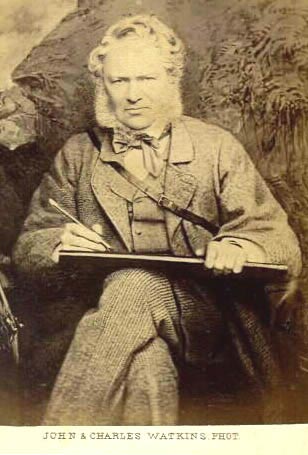
Edwin Landseer was born in 1802 in London. He was one of seven children of John Landseer, an engraver, who taught all his children the skill of engraving. One of Landseer's brothers was a painter, the other followed in his father's footsteps and became an engraver, and two of his sisters were painters of miniatures. Edwin began sketching at the age of four. At fourteen he was admitted to the Royal Academy Schools in London. At twenty-four he was elected an Associate of the Academy, the earliest age possible for an artist to receive that honor. He was elected a Fellow of the Academy at age twenty-nine. In his lifetime, Edwin Landseer attracted many patrons, among them Queen Victoria and Prince Albert.
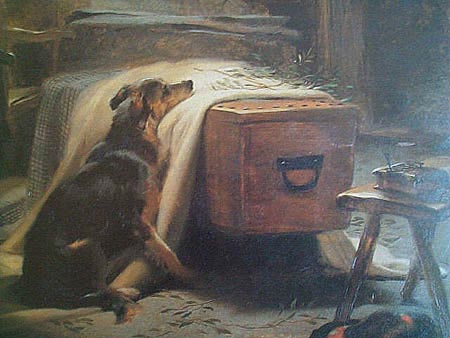 In 1824, Landseer visited Scotland for the first time. The
scenery and history of the country made a deep impression on him, and
the Highlands continued to be prominent among the subjects of his
paintings. He painted portraits of many notable Scots of the day. Among
them is a famous portrait of Sir Walter Scott that hangs in the National
Gallery in London. Sir Walter wrote "Landseer's dogs were the most
magnificent things I ever saw...". Animal portraits, and in particular,
paintings and engravings of dogs, were a continuing theme of Landseer's.
Many were of sheepdogs. The most moving of these was "The Old Shepherd's
Chief Mourner", left, painted in 1837. It shows a black and tan shepherd's collie,
lying with his chest pressed against the side of his dead master's
coffin, his chin resting forlornly on the coffin lid that the black
and white checked shepherd's plaid is draped across.
In 1824, Landseer visited Scotland for the first time. The
scenery and history of the country made a deep impression on him, and
the Highlands continued to be prominent among the subjects of his
paintings. He painted portraits of many notable Scots of the day. Among
them is a famous portrait of Sir Walter Scott that hangs in the National
Gallery in London. Sir Walter wrote "Landseer's dogs were the most
magnificent things I ever saw...". Animal portraits, and in particular,
paintings and engravings of dogs, were a continuing theme of Landseer's.
Many were of sheepdogs. The most moving of these was "The Old Shepherd's
Chief Mourner", left, painted in 1837. It shows a black and tan shepherd's collie,
lying with his chest pressed against the side of his dead master's
coffin, his chin resting forlornly on the coffin lid that the black
and white checked shepherd's plaid is draped across.
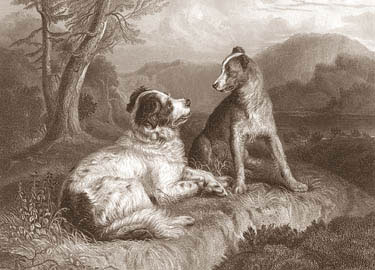 "The Twa Dogs" was painted by Landseer to illustrate Robert Burn's poem of the same name. It shows Caesar, a so-called Landseer Newfoundland (the type named for Landseer because the artist depicted this type of dog in many of his paintings), and Luath, a working collie named for Burn's own collie, who appears as a smooth-coated dog in Lanseer's portayal.
"The Twa Dogs" was painted by Landseer to illustrate Robert Burn's poem of the same name. It shows Caesar, a so-called Landseer Newfoundland (the type named for Landseer because the artist depicted this type of dog in many of his paintings), and Luath, a working collie named for Burn's own collie, who appears as a smooth-coated dog in Lanseer's portayal.
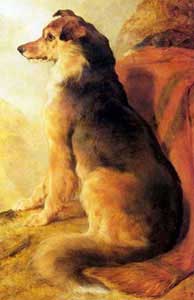 I am not certain about the picture on the right, but I believe it to have been painted by Landseer. It is very much in keeping with his style. It is a detail from a larger painting and shows a gorgeous collie waiting for his master. The plaid he is sitting on was a favorite device used by many artists of the day to indicate a dog is waiting for the owner of the plaid to return and claim it.
I am not certain about the picture on the right, but I believe it to have been painted by Landseer. It is very much in keeping with his style. It is a detail from a larger painting and shows a gorgeous collie waiting for his master. The plaid he is sitting on was a favorite device used by many artists of the day to indicate a dog is waiting for the owner of the plaid to return and claim it.
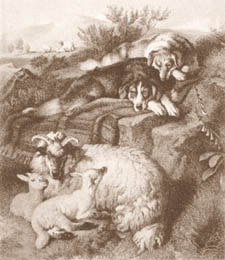
"The Twins" by Landseer
refers to the twin lambs,
not to the two sheepdogs.
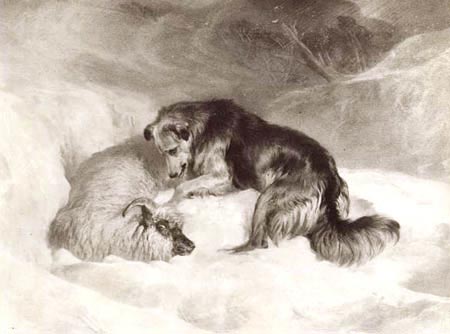
"Collie rescuing a sheep" by Landseer shows a collie digging a sheep out of the snow.
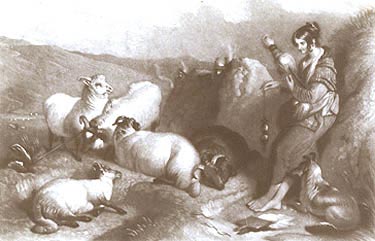
A lithograph of a shepherdess and her flock by Landseer, includes a collie sitting at
his mistress' feet, relaxed but still alert, watching the flock. There are numerous images in
this scene which, although romantisized, show that Landseer understood the environment that
he was portraying. The scene takes place on the hill behind the "black house" in which the
woman supposedly lived. The house has a thatched roof and no chimney, and we can see the smoke
escaping through the thatch, a phenomenon that left soot behind under the roof and gave the
house its name. There are only a few sheep, which was the custom in the Highlands. One sheep
is tethered, possibly the ram, which kept the flock from wandering. The shepherdess is
spinning on a drop spindle, which she twirls with her right hand, drawing fibers from the
fleece on her distaff with her left hand. On the ground are a pair of handcards for carding
the wool.
 Some head studies painted by Landseer includes a shepherd's dog.
Some head studies painted by Landseer includes a shepherd's dog.
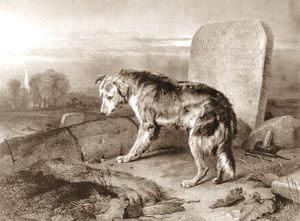 Another sad painting called
Another sad painting called
"The Shepherd's Grave"
shows a forlorn collie
on his master's grave.

So, to end on a higher note, above is a painting of Landseer's called "Peace". It shows a
family having a "picnic" on the rocks above the sea, among the sheep and goats. It's a
beautiful day, one that is seldom seen in the Highlands of Scotland (at least not in Landseer's
paintings) and indeed a peaceful scene. The collie fast asleep in the left forground and the
other animals are lounging about. Note the two goats in the right foreground with little
saddles on their backs! One (or perhaps both) also has a yoke that implies it pulls a cart.
THE OTHER WEB PAGES WE MAINTAIN
These web pages are copyright ©2013
and maintained by webmeistress Carole Presberg
with technical help from webwizard David Presberg
ALL RIGHTS RESERVED
If you are interested in using ANY material on this website, you MUST first ask for permission.